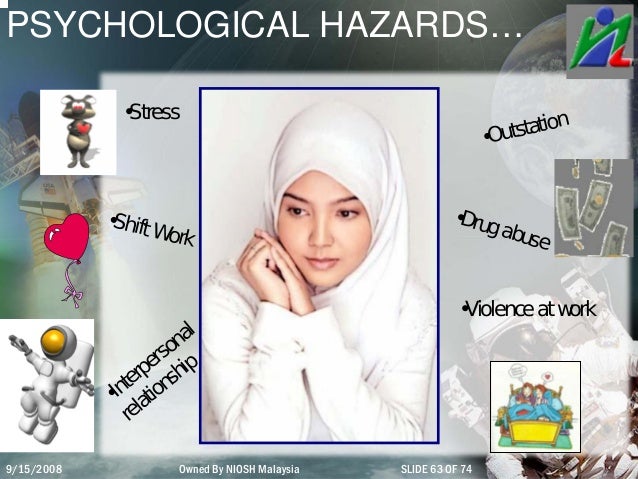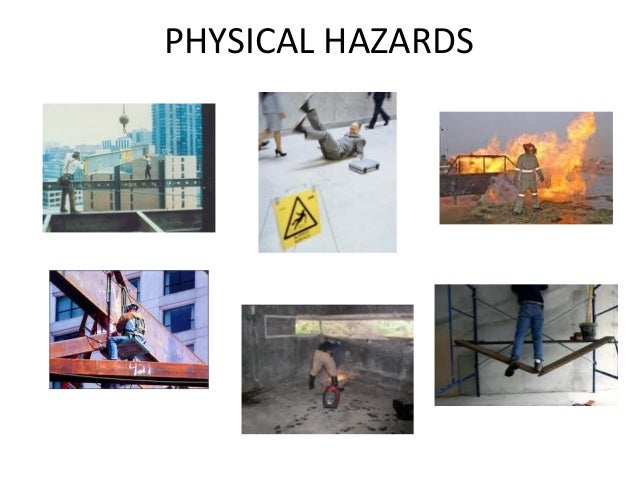What is a hazard?
A hazard is any source of potential damage, harm or adverse health effects on something or someone under certain conditions at work.
Basically, a hazard can cause harm or adverse effects (to individuals as health effects or to organizations as property or equipment losses).
Sometimes a hazard is referred to as being the actual harm or the health effect it caused rather than the hazard. For example, the disease tuberculosis (TB) might be called a hazard by some but in general the TB-causing bacteria would be considered the "hazard" or "hazardous biological agent".
What are examples of a Hazard?
Workplace hazards can come from a wide range of sources. General examples include any substance, material, process, practice, etc that has the ability to cause harm or adverse health effect to a person under certain conditions.
What is Risk?
Risk is the chance or probability that a person will be harmed or experience an adverse health effect if exposed to a hazard. It may also apply to situations with property or equipment loss.
For example: The risk of developing cancer from smoking cigarettes could be expressed as "cigarette smokers are 12 times (for example) more likely to die of lung cancer than nonsmokers". Another way of reporting risk is "a certain number ,"Y", of smokers per 100,000 smokers will likely develop lung cancer" (depending on their age and how many years they have been smoking).
These risks are expressed as a probability or likelihood of developing a disease or getting injured, whereas hazards refer to the possible consequences (e.g., lung cancer, emphysema and heart disease from cigarette smoking).
Factors that influence the degree of risk include:
how much a person is exposed to a hazardous thing or condition,
how the person is exposed (e.g., breathing in a vapor, skin contact), and
how severe are the effects under the conditions of exposure.
What is a risk assessment?
Risk assessment is the process where you:
identify hazards,
analyze or evaluate the risk associated with that hazard, and
determine appropriate ways to eliminate or control the hazard.
The OSH Answers Risk Assessment has details on how to conduct an assessment and establish priorities.
What is an adverse health effect?
A general definition of adverse health effect is "any change in body function or the structures of cells that can lead to disease or health problems". Adverse health effects include:
bodily injury,
disease,
change in the way the body functions, grows, or develops,
effects on a developing fetus (teratogenic effects, fetotoxic effects),
effects on children, grandchildren, etc. (inheritable genetic effects)
decrease in life span,
change in mental condition resulting from stress, traumatic experiences, exposure to solvents, and so on.
effects on the ability to accommodate additional stress.
Will exposure to hazards in the workplace always cause injury, illness or other adverse health effects?
The effects can be acute, meaning that the injury or harm can occur or be felt as soon as a person comes in contact with the hazardous agent (e.g., a splash of acid in a person's eyes).
Some responses to may be chronic (delayed). For example, exposure to poison ivy may cause red swelling on the skin two to six hours after contact with the plant. On the other hand, longer delays are possible: mesothelioma, a kind of cancer in the lining in the lung cavity, can develop over 20 years or more after exposure to asbestos.
Once the hazard is removed or eliminated, the effects may be reversible or irreversible. For example, a hazard may cause an injury that can heal completely (reversible) or result in an untreatable disease (irreversible).
Types of Hazard
1. Chemical - A chemical hazard is any substance that can cause harm, primarily to people. Chemicals of all kinds are stored in our homes and can result in serious injuries if not properly handled. Household items such as bleach can result in harmful chlorine gas or hydrochloric acid if carelessly used. Gasoline fumes from containers for lawnmowers or boats can result in major health hazards if inhaled.
| http://www.homestructions.com/wp-content/uploads/2013/03/iStock_000017046872Small.jpg |
An electric hazard is considered to be removed when protective measures are put in place at the source (remove hazard or de energize), or along the path (place electrical insulation/barrier between the worker and the electrical hazard).
3. Ergonomic - Ergonomic hazards impact employers and workers and their families. Poor workplace design, awkward body mechanics or postures, repetitive movements, and other ergonomic hazards induce or contribute to a staggering number of cumulative trauma disorders.
Cumulative trauma disorders (CTD) affect hands, wrists, elbows, arms, shoulders, the lower back, and the cervical spine area. Structures involved include tendons, muscles, bones, nerves, and blood vessels. One can plan strategies for abatement by learning to recognize the hazards that contribute to CTD.
 |
| https://image.slidesharecdn.com/niosh1-140622120855-phpapp01/95/niosh1-63-638.jpg?cb=1403438984 |
5. Radiation - Radiation Hazard (RADHAZ) describes the hazards of electromagnetic radiation to fuels, electronic hardware, ordinance, and personnel. In the military these hazards are segregated as follows:
1) Hazards of Electromagnetic Radiation to Personnel (HERP)
2) Hazards of Electromagnetic Radiation to Ordnance (HERO)
3) Hazards of Electromagnetic Radiation to Fuel (HERF)
 |
| https://image.slidesharecdn.com/occupationalhazards-131016125422-phpapp01/95/occupational-hazards-39-638.jpg?cb=1381928433 |
6. Biological - A biological hazard, or biohazard, is anything coming from living organisms (i.e. pollen, fungi, animals, insects, bacteria and viruses) that could be a threat to someone's health. It is represented by ☣, the biohazard symbol, which is used everywhere in the world. When people see this sign they know to take precautions, and to follow proper conduct for science labs.
 |
| https://image.slidesharecdn.com/physicalhazard-130913024629-phpapp01/95/physical-hazard-2-638.jpg?cb=1379042132 |
* Fire
* Explosion
* Chemical Reactivity
Hazards may be encountered when using the sewing machine include :
Cuts and injuries from sharp edges , knife blades, scissors and pins - Finger injuries while sewing
Back injury from poor posture and improper lifting procedures - Eye strain from poor lighting



Comments
Post a Comment